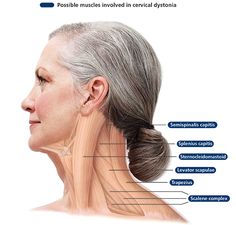
Spasmodic Torticollis is also known as cervical dystonia. It is a painful condition of the head and neck. In spasmodic torticollis, the muscles of the neck involuntarily contract. This causes the neck to twist to one side. The contractions can be tonic, meaning that the neck turns to one side. They can also be clonic, which means that there is a shaking motion of the head and neck. Although it can occur at any age, spasmodic torticollis usually occurs in middle-aged patients with a female preponderance. The muscle contractions can cause the head and neck to twist in a variety of directions. This includes rotation, lateral bending, retrocollis (bending backwards) or anterocollis (bending forward). Early in the disease, the symptoms may be intermittent. As the disease progresses, the symptoms become more severe. The disease is associated with pain and aching of the muscles. Headaches are not uncommon. MRI of the brain is necessary to exclude intracranial causes of this problem, including tumors. Angiography is used to look for aneurysms of the blood vessels. The diagnosis of spasmodic torticollis is made by history and physical exam. Some psychiatric problems can mimic this disorder and need to be excluded. Acute spasm of the neck, or wry neck, can also be confused with spasmodic torticollis but usually resolves within days. Certain drugs and medications can cause neck spasm, including anti-psychotic medications and medications used to treat nausea. Treatment of spasmodic torticollis is disappointing and includes muscle relaxants and anti-convulsants. Injection into the muscles of Botulinum toxin may be helpful. In refractory cases, surgery to cut the affected nerves or muscles can be tried. Deep brain stimulation has also be used to try to decrease the symptoms of spasmodic torticollis.